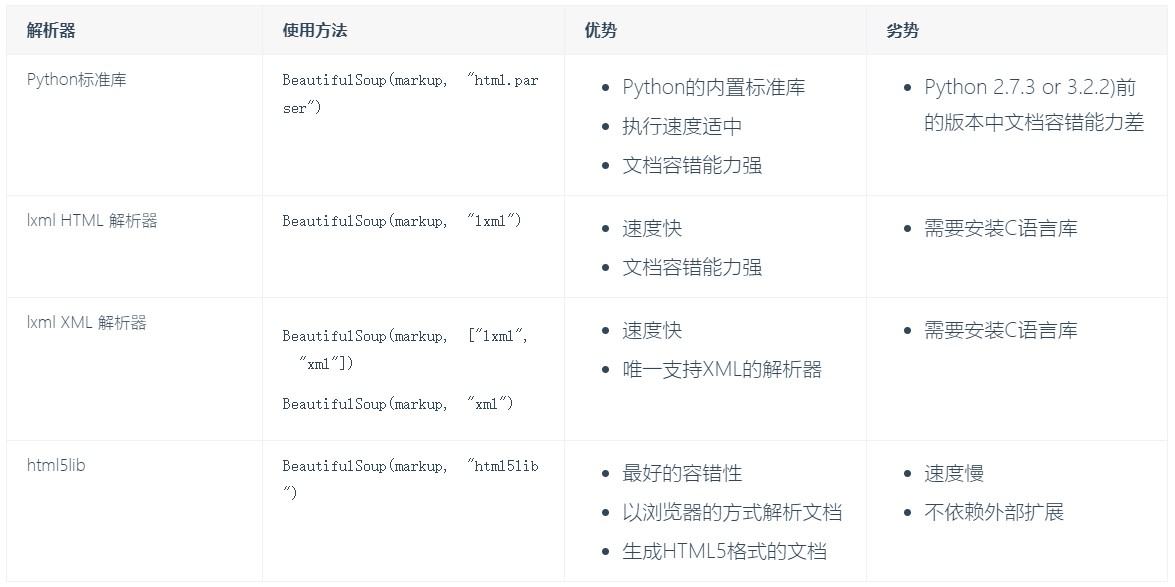BeautifulSoup4
目录
1. BeautifulSoup4简介
官方文档:https://www.crummy.com/software/BeautifulSoup/bs4/doc/index.zh.html
Beautiful Soup 是一个可以从HTML或XML文件中提取数据的Python库。它能够通过你喜欢的转换器实现惯用的文档导航,查找,修改文档的方式。Beautiful Soup会帮你节省数小时甚至数天的工作时间.你可能在寻找 Beautiful Soup3 的文档,Beautiful Soup 3 目前已经停止开发,官网推荐在现在的项目中使用Beautiful Soup 4, 移植到BS4。
2. 安装
- 安装Beautiful Soup 4
pip install beautifulsoup4
- 安装解析器
Beautiful Soup支持Python标准库中的HTML解析器,还支持一些第三方的解析器,其中一个是 lxml 。根据操作系统不同,可以选择下列方法来安装lxml:
$ apt-get install Python-lxml
$ easy_install lxml
$ pip install lxml
另一个可供选择的解析器是纯Python实现的 html5lib,html5lib的解析方式与浏览器相同,可以选择下列方法来安装html5lib:
$ apt-get install Python-html5lib
$ easy_install html5lib
$ pip install html5lib
bs4支持的解析器,推荐使用lxml

3. 使用
3.1 基本使用
html_doc = """
<html><head><title>The Dormouse's story</title></head>
<body>
<p class="title"><b>The Dormouse's story</b></p>
<p class="story">Once upon a time there were three little sisters; and their names were
<a href="http://example.com/elsie" class="sister" id="link1">Elsie</a>,
<a href="http://example.com/lacie" class="sister" id="link2">Lacie</a> and
<a href="http://example.com/tillie" class="sister" id="link3">Tillie</a>;
and they lived at the bottom of a well.</p>
<p class="story">...</p>
"""
# 基本使用:容错处理,文档的容错能力指的是在html代码不完整的情况下,使用该模块可以识别该错误。使用BeautifulSoup解析上述代码,能够得到一个 BeautifulSoup 的对象,并能按照标准的缩进格式的结构输出
from bs4 import BeautifulSoup
soup = BeautifulSoup(html_doc, 'lxml') # 具有容错功能
res = soup.prettify() # 处理好缩进,结构化显示
print(res)
3.2 遍历文档树
# html文档
html_doc.html = '''
<html><head><title>The Dormouse's story</title></head>
<body>
<p id="my p" class="title"><b id="bbb" class="boldest">The Dormouse's story</b></p>
<p class="story">Once upon a time there were three little sisters; and their names were
<a href="http://example.com/elsie" class="sister" id="link1">Elsie</a>,
<a href="http://example.com/lacie" class="sister" id="link2">Lacie</a> and
<a href="http://example.com/tillie" class="sister" id="link3">Tillie</a>;
and they lived at the bottom of a well.</p>
<p class="story">...</p>
</body>
'''
# 遍历文档树:即直接通过标签名字选择,特点是选择速度快,但如果存在多个相同的标签则只返回第一个
# 1. 用法
from bs4 import BeautifulSoup
soup = BeautifulSoup(html_doc, 'lxml')
# soup=BeautifulSoup(open('a.html'), 'lxml')
print(soup.p) # 存在多个相同的标签则只返回第一个
print(soup.a) # 存在多个相同的标签则只返回第一个
# 2. 获取标签的名称
print(soup.p.name)
# 3. 获取标签的属性
print(soup.p.attrs)
# 4. 获取标签的内容
print(soup.p.string) # p下的文本只有一个时,取到,否则为None
print(soup.p.strings) # 拿到一个生成器对象, 取到p下所有的文本内容
print(soup.p.text) # 取到p下所有的文本内容
for line in soup.stripped_strings: # 去掉空白
print(line)
'''
如果tag包含了多个子节点,tag就无法确定 .string 方法应该调用哪个子节点的内容,.string 的输出结果是 None,如果只有一个子节点那么就输出该子节点的文本,比如下面的这种结构,soup.p.string 返回为None,但soup.p.strings就可以找到所有文本
<p id='list-1'>
哈哈哈哈
<a class='sss'>
<span>
<h1>aaaa</h1>
</span>
</a>
<b>bbbbb</b>
</p>
'''
# 5.嵌套选择
print(soup.head.title.string)
print(soup.body.a.string)
# 6. 子节点、子孙节点
print(soup.p.contents) # p下所有子节点
print(soup.p.children) # 得到一个迭代器,包含p下所有子节点
for i,child in enumerate(soup.p.children):
print(i,child)
print(soup.p.descendants) # 获取子孙节点,p下所有的标签都会选择出来
for i,child in enumerate(soup.p.descendants):
print(i,child)
# 7. 父节点、祖先节点
print(soup.a.parent) #获取a标签的父节点
print(soup.a.parents) #找到a标签所有的祖先节点,父亲的父亲,父亲的父亲的父亲...
# 8. 兄弟节点
print('=====>')
print(soup.a.next_sibling) # 下一个兄弟
print(soup.a.previous_sibling) # 上一个兄弟
print(list(soup.a.next_siblings)) # 下面的兄弟们=>生成器对象
print(soup.a.previous_siblings) # 上面的兄弟们=>生成器对象
3.3 搜索文档树
3.3.1 五种过滤器
# 搜索文档树:BeautifulSoup定义了很多搜索方法,这里着重介绍2个: find()和find_all(),其它方法的参数和用法类似
html_doc = """
<html><head><title>The Dormouse's story</title></head>
<body>
<p id="my p" class="title"><b id="bbb" class="boldest">The Dormouse's story</b>
</p>
<p class="story">Once upon a time there were three little sisters; and their names were
<a href="http://example.com/elsie" class="sister" id="link1">Elsie</a>,
<a href="http://example.com/lacie" class="sister" id="link2">Lacie</a> and
<a href="http://example.com/tillie" class="sister" id="link3">Tillie</a>;
and they lived at the bottom of a well.</p>
<p class="story">...</p>
"""
from bs4 import BeautifulSoup
soup = BeautifulSoup(html_doc,'lxml')
# 五种过滤器: 字符串、正则表达式、列表、True、方法
# 1. 字符串:即标签名
print(soup.find_all('b'))
# 2. 正则表达式
import re
print(soup.find_all(re.compile('^b'))) # 找出b开头的标签,结果有body和b标签
# 3. 列表:如果传入列表参数,Beautiful Soup会将与列表中任一元素匹配的内容返回,下面代码找到文档中所有<a>标签和<b>标签:
print(soup.find_all(['a', 'b']))
# 4. True:可以匹配任何值,下面代码查找到所有的tag,但是不会返回字符串节点
print(soup.find_all(True))
for tag in soup.find_all(True):
print(tag.name)
# 5. 方法:如果没有合适过滤器,那么还可以定义一个方法,方法只接受一个元素参数,如果这个方法返回 True 表示当前元素匹配并且被找到,如果不是则反回 False
def has_class_but_no_id(tag):
return tag.has_attr('class') and not tag.has_attr('id')
print(soup.find_all(has_class_but_no_id))
3.3.2 find_all(name, attrs, recursive, text, **kwargs)
# find_all( name , attrs , recursive , text , **kwargs )
# 1. name: 搜索name参数的值可以使任一类型的 过滤器,字符串,正则表达式,列表,方法或是 True .
print(soup.find_all(name=re.compile('^t')))
# 2. keyword: key=value的形式,value可以是过滤器:字符串,正则表达式,列表,True .
print(soup.find_all(id=re.compile('my')))
print(soup.find_all(href=re.compile('lacie'), id=re.compile('\d'))) # 注意类要用class_
print(soup.find_all(id=True)) # 查找有id属性的标签
# 有些tag属性在搜索不能使用,比如HTML5中的 data-* 属性:
data_soup = BeautifulSoup('<div data-foo="value">foo!</div>', 'lxml')
# data_soup.find_all(data-foo="value") #报错:SyntaxError: keyword can't be an expression
# 但是可以通过 find_all() 方法的 attrs 参数定义一个字典参数来搜索包含特殊属性的tag:
print(data_soup.find_all(attrs={"data-foo": "value"}))
# [<div data-foo="value">foo!</div>]
# 3. 按照类名查找,注意关键字是class_,class_=value,value可以是五种选择器之一
print(soup.find_all('a', class_='sister')) # 查找类为sister的a标签
print(soup.find_all('a', class_='sister ssss')) # 查找类为sister和sss的a标签,顺序错误也匹配不成功
print(soup.find_all(class_=re.compile('^sis'))) # 查找类为sister的所有标签
# 4. attrs
print(soup.find_all('p', attrs={'class': 'story'}))
# 5. text: 值可以是:字符,列表,True,正则
print(soup.find_all(text='Elsie'))
print(soup.find_all('a', text='Elsie'))
# 6. limit参数:如果文档树很大那么搜索会很慢,如果我们不需要全部结果,可以使用 limit 参数限制返回结果的数量,效果与SQL中的limit关键字类似,当搜索到的结果数量达到 limit 的限制时,就停止搜索返回结果
print(soup.find_all('a', limit=2))
# 7. recursive:调用tag的 find_all() 方法时,Beautiful Soup会检索当前tag的所有子孙节点,如果只想搜索tag的直接子节点,可以使用参数 recursive=False。
print(soup.html.find_all('a'))
print(soup.html.find_all('a', recursive=False))
'''
像调用 find_all() 一样调用tag
find_all() 几乎是Beautiful Soup中最常用的搜索方法,所以我们定义了它的简写方法。BeautifulSoup 对象和 tag 对象可以被当作一个方法来使用,这个方法的执行结果与调用这个对象的 find_all() 方法相同,下面两行代码是等价的:
soup.find_all("a")
soup("a")
这两行代码也是等价的:
soup.title.find_all(text=True)
soup.title(text=True)
'''
3.3.3 find(name, attrs, recursive, text, **kwargs)
# find(name , attrs , recursive , text , **kwargs)
# find_all() 方法将返回文档中符合条件的所有tag,尽管有时候我们只想得到一个结果。比如文档中只有一个<body>标签,那么使用 find_all() 方法来查找<body>标签就不太合适,使用 find_all 方法并设置 limit=1 参数不如直接使用 find() 方法。下面两行代码是等价的:
soup.find_all('title', limit=1)
# [<title>The Dormouse's story</title>]
soup.find('title')
# <title>The Dormouse's story</title>
# 唯一的区别是 find_all() 方法的返回结果是值包含一个元素的列表,而find()方法直接返回结果.
# find_all() 方法没有找到目标是返回空列表,find()方法找不到目标时,返回None.
print(soup.find("nosuchtag"))
# None
# soup.head.title 是 tag的名字 方法的简写,这个简写的原理就是多次调用当前tag的find()方法:
soup.head.title
# <title>The Dormouse's story</title>
soup.find("head").find("title")
# <title>The Dormouse's story</title>
3.3.4 CSS选择器
# 该模块提供了select方法来支持css,详见官网:https://www.crummy.com/software/BeautifulSoup/bs4/doc/index.zh.html#id37
html_doc = """
<html><head><title>The Dormouse's story</title></head>
<body>
<p class="title">
<b>The Dormouse's story</b>
Once upon a time there were three little sisters; and their names were
<a href="http://example.com/elsie" class="sister" id="link1">
<span>Elsie</span>
</a>
<a href="http://example.com/lacie" class="sister" id="link2">Lacie</a> and
<a href="http://example.com/tillie" class="sister" id="link3">Tillie</a>;
<div class='panel-1'>
<ul class='list' id='list-1'>
<li class='element'>Foo</li>
<li class='element'>Bar</li>
<li class='element'>Jay</li>
</ul>
<ul class='list list-small' id='list-2'>
<li class='element'><h1 class='yyyy'>Foo</h1></li>
<li class='element xxx'>Bar</li>
<li class='element'>Jay</li>
</ul>
</div>
and they lived at the bottom of a well.
</p>
<p class="story">...</p>
"""
from bs4 import BeautifulSoup
soup = BeautifulSoup(html_doc, 'lxml')
# 1. CSS选择器
print(soup.p.select('.sister'))
print(soup.select('.sister span'))
print(soup.select('#link1'))
print(soup.select('#link1 span'))
print(soup.select('#list-2 .element.xxx'))
print(soup.select('#list-2')[0].select('.element')) # 可以一直select,但其实没必要,一条select就可以了
# 2. 获取属性
print(soup.select('#list-2 h1')[0].attrs)
# 3. 获取内容
print(soup.select('#list-2 h1')[0].get_text())


 浙公网安备 33010602011771号
浙公网安备 33010602011771号